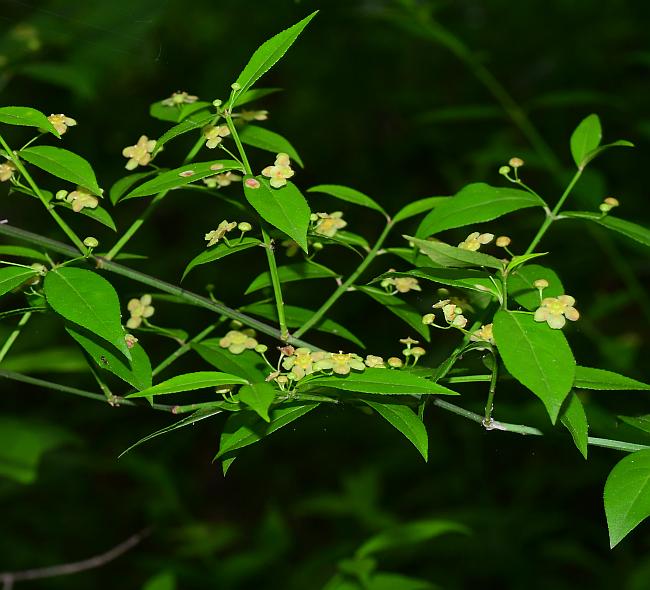Euonymus americanus L.
Strawberry Bush

Native
CC = 10
CW = 0
MOC = 10
SRank = S2
© SRTurner
Euonymus americanus L.Strawberry Bush | |
 |
Native CC = 10 CW = 0 MOC = 10 SRank = S2 |
© SRTurner |
|
Family - Celastraceae Habit - Shrub to 2 m tall. Stems - Ascending or erect, with spreading branches, the lowermost branches occasionally rooting. Twigs green, angled but not winged.
Leaves - Opposite, simple, very short petiolate, thin and herbaceous, deciduous. Petiole to 1 mm long. Leaf blades 2-9 cm long, 1-4 cm wide, lanceolate to elliptic or ovate, narrowed or tapered at the base, narrowed or tapered to a usually sharply pointed tip, the surfaces glabrous or inconspicuously hairy, the margins finely and usually bluntly toothed.
Inflorescences - Axillary clusters of 2 or 3 or solitary flowers, often all but 1 flower aborting during development.
Flowers - Usually perfect. Sepals 5, 1-2 mm long. Petals 5, 2-4 mm long, 2-3 mm wide, broadly spatulate with a short, stalklike base, greenish yellow, sometimes tinged with purple or brown, the margins mostly entire. Stamens 5, inserted along the margin of the nectar disc, the filaments minute (0.1-0.5 mm). Ovary usually with 1-5 locules and 2-6 ovules per locule. Style short, stout, the stigma entire or shallowly 3-lobed.
Fruits - Capsules 14-16 mm long, 3-5-lobed most of their length, the valves strongly warty, pink to red or purplish red when mature. Seeds 1-6 per locule, 4-5 mm long, enclosed in a fleshy red aril.
Flowering - April - June. Habitat - Swamps, bottomland forests, mesic forest ravines, and bases of sheltered bluffs, streambanks. Sometimes cultivated. Origin - Native to the U.S. Lookalikes - None when flowering. Other info. - This attractive species can be found in the southeastern section of Missouri. This is near the northwestern extent of the plant's natural range, which is mostly within the southeastern quadrant of the continental U.S. Identification of flowering or fruiting plants is easy, as the fertile structures are unique in appearance among Missouri's wild flora. When young, the plant is sprawling and trailing, spreading rapidly. As it ages, it becomes more erect, and the stems become much thinker and branched. This species grows well from seed and can be easily cultivated. Despite their strawberry-like appearance, the fruits are not edible and will cause severe diarrhea. Photographs taken in Brown Summit, NC., 5-10-02 and 10-1-02 (DETenaglia); also at Millstream Gardens Conservation Area, Madison County, MO, 6-26-2017 and 5-21-2020 (SRTurner); also in St. Louis, St. Louis County, MO, 9-19-2022 (KBildner). |